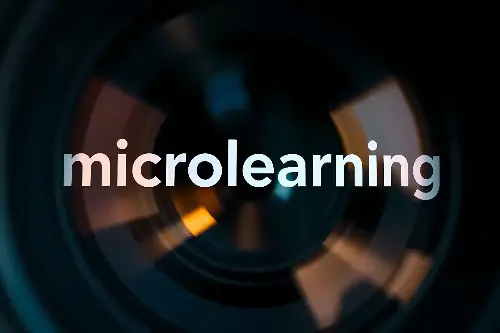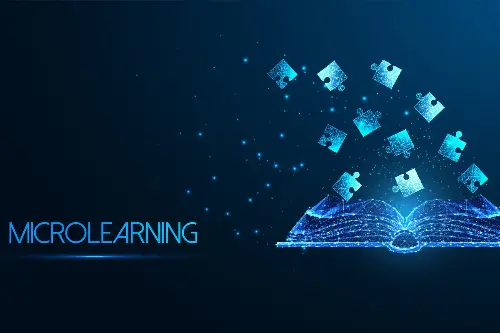In an age where information bombards us from every angle, the ability to absorb, retain, and apply complex subjects has become an increasingly demanding task. Enter micro-learning: a trend in educational methodology that breaks down complicated topics into manageable, bite-sized pieces. This innovative learning strategy aligns perfectly with the digital age, catering to the modern learner's short attention span and on-the-go lifestyle.

Micro-learning capitalises on the principle that smaller learning units and shorter-term learning activities lead to more profound understanding and retention. But what exactly makes this approach so effective? The key lies in its design to work with our cognitive architecture—our brains are wired to process and remember small chunks of information at a time. This way, micro-learning combats the dreaded information overload, which can hinder the learning process.
Components of Micro-Learning
So what constitutes a micro-learning module? Generally, these are short-term focused strategies designed to meet a specific learning outcome. Each module typically lasts between 2 to 5 minutes and exists in various forms; such as a video, an interactive activity, a quiz, or even a short article. By focusing on one key objective at a time, these modules promote targeted learning that fits neatly into one’s busy schedule.
Adapting Micro-Learning for Complex Subjects
The challenge of simplifying complex subjects without oversimplifying them is one that micro-learning approaches with finesse. To do this, micro-learning slices a complex topic into fundamental concepts that serve as the building blocks for understanding the larger subject. For example, imagine trying to master a new language. Rather than being overwhelmed by grammar, vocabulary, and pronunciation all at once, a micro-learning approach would break this down into daily short exercises focusing on each element individually.

Innovative Techniques in Micro-Learning
Within the umbrella of micro-learning, a variety of innovative techniques are employed to enhance learning and retention. Spaced repetition, for instance, is a learning technique that involves repeating content at increasing intervals. This has proved to be incredibly effective in committing information to long-term memory. Additionally, gamification adds elements of play to learning, making the absorption of complex subjects not only manageable but also enjoyable.
The Power of Just-In-Time Learning
Micro-learning excels in just-in-time learning: the provision of learning resources precisely at the time when a learner needs them. This mode of learning is particularly beneficial when dealing with complex subjects that you may need to apply in a real-world context. Applying just-in-time learning could mean accessing a quick tutorial right before you perform a complicated task at work, thereby directly relating the learning process to practical application.

Incorporating Micro-Learning into Your Routine
How do modern learners integrate micro-learning into their daily lives? The answer is simpler than one might think. By its very nature, micro-learning is meant to be a flexible approach, fitting around and adapting to the learner’s lifestyle. Whether it’s listening to a micro-podcast while commuting or completing a short interactive module during a lunch break, micro-learning tools can be accessed anytime, anywhere, through smartphones, tablets, or laptops.
The Role of Technology and Digital Platforms
Indeed, technology serves as the backbone of the micro-learning framework, with a myriad of digital platforms offering courses and modules in numerous disciplines. Apps that specialise in language learning, coding, or even cooking, are vivid examples of micro-learning platforms. They not only curate content into digestible lessons but also use algorithms to adapt their offerings based on users' performance and preferences.
Advantages of Micro-Learning for Educators and Learners
Micro-learning doesn't just benefit the learners; educators and institutions can also reap its rewards. For educators, it offers an effective way to deliver content that is more engaging and less likely to overwhelm students. Meanwhile, for institutions, it presents an opportunity to modernise their educational offerings, making them more accessible and conducive to contemporary learning habits.

Challenges and Considerations
Nevertheless, micro-learning is not without its challenges. Care must be taken to ensure that each learning bit is contextually connected to the bigger picture. The risk of fragmenting knowledge too much is that learners could miss out on the holistic view of a subject. Therefore, careful design and planning are required to balance depth with simplicity.
The Future of Learning with Micro-Learning
As we look ahead, it's clear that micro-learning will play an integral role in shaping the future of education. With its compatibility with modern life's demands and the technological advancements that support it, micro-learning adapts education for the better. It provides an answer to the paradox of our time: how to simplify complex subjects in a world that increasingly values deep knowledge.
In conclusion, micro-learning stands as a beacon of innovation in the education field. It challenges traditional learning models and provides a solution that is not only efficacious but also adaptative to the fast-paced, distraction-filled world we inhabit. For anyone seeking to tackle new subjects or enhance their expertise, micro-learning proves that with the right approach, learning can be a manageable, continuous, and, most importantly, enjoyable journey.
